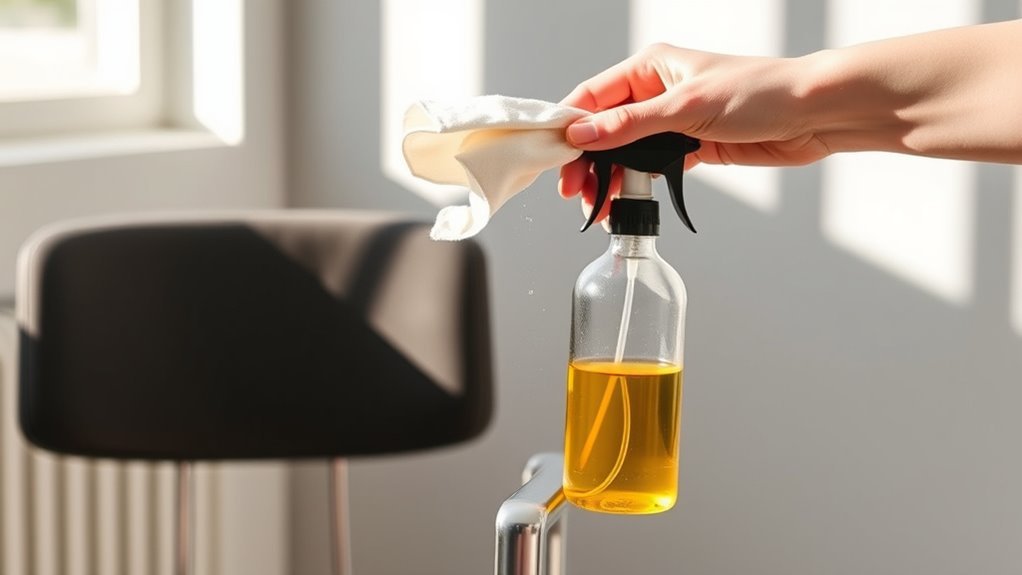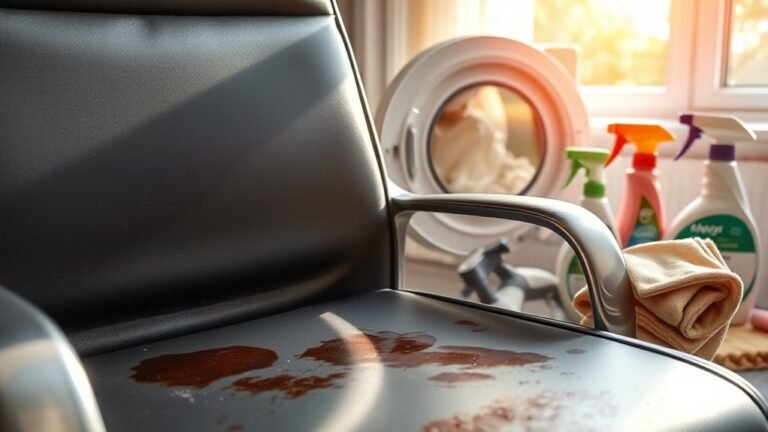Using Essential Oils to Clean Office Chair
You can clean your office chair naturally by mixing essential oils like tea tree or lavender, known for their antimicrobial properties, with water or a mild carrier. Always test the solution on a hidden spot first to avoid damage or discoloration. For fabric chairs, gently blot stains and air dry; leather needs a diluted oil with carrier for gentle conditioning. Using essential oils not only cleans but also freshens your chair safely. Discover more tips to keep your workspace inviting and hygienic.
Benefits of Using Essential Oils for Cleaning

Although many cleaning products contain harsh chemicals, essential oils offer a natural and effective alternative for cleaning your office chair. By choosing essential oils, you reduce the environmental impact associated with synthetic cleaners, minimizing toxic residues and pollution. This aligns with a cleaner, greener lifestyle, giving you the freedom to maintain a healthy workspace. Additionally, essential oils are highly concentrated, meaning you use smaller quantities compared to conventional products, which enhances cost effectiveness. You won’t need to repurchase frequently, saving money over time. Their antimicrobial properties guarantee your chair remains hygienic without harsh additives. Embracing essential oils empowers you to clean efficiently while supporting sustainability and budget-conscious choices. This method offers a clear, responsible path for maintaining your office environment.
Choosing the Right Essential Oils for Office Chairs
When selecting essential oils for your office chair, focus on types that are safe for fabric and offer strong antimicrobial properties, like tea tree or eucalyptus. You’ll also want to take into account how the scent affects your workspace, choosing aromas that promote focus without overwhelming. Balancing these factors guarantees effective cleaning while maintaining a pleasant environment.
Oil Types for Fabric
Since office chairs often feature delicate fabrics, you’ll want to select essential oils that are both effective and gentle enough to avoid damage or discoloration. Opt for oil blends specifically formulated for fabric care, as they balance potency with mildness. Lavender and chamomile oils are excellent choices—they clean without compromising fabric integrity or leaving harsh residues. Avoid citrus-based oils like lemon or orange on delicate textiles, as their acidity may cause fading. When using oil blends, always dilute them with water or a carrier oil to guarantee safe application. This approach not only preserves your chair’s fabric but also harnesses the therapeutic benefits of essential oils. By choosing the right oils, you maintain both cleanliness and the freedom to enjoy a fresh, inviting workspace.
Antimicrobial Properties Explained
Understanding the antimicrobial properties of essential oils is crucial if you want to effectively clean and maintain your office chair. Different essential oil types offer varying levels of antimicrobial effectiveness, which helps combat bacteria, fungi, and viruses on your chair’s surface. Choosing oils with proven antimicrobial activity guarantees a cleaner, healthier workspace.
Here are essential oil types known for their antimicrobial effectiveness:
- Tea tree oil: potent against bacteria and fungi
- Eucalyptus oil: effective antiviral and antibacterial properties
- Lavender oil: antimicrobial and soothing for fabric
- Peppermint oil: strong antibacterial effect with a fresh scent
- Lemon oil: natural disinfectant with antimicrobial action
Selecting the right oils lets you maintain cleanliness while preserving your chair’s fabric and promoting a hygienic environment.
Scent Impact on Workspace
After selecting the right oils for their antimicrobial benefits, you’ll also want to contemplate how their scents influence your workspace. The aroma of essential oils can shape your environment through scent memory, linking specific smells to focus and calm. For example, lavender promotes relaxation, while peppermint can deliver a productivity boost by enhancing alertness. Choosing oils with pleasant, non-overpowering scents guarantees you stay energized without distraction. Consider citrus oils like lemon or orange, which refresh the air and uplift mood, fostering a dynamic workspace. Balancing antimicrobial efficacy with scent preference lets you maintain a clean chair and a mentally stimulating atmosphere. By tailoring your essential oil choices, you create a workspace that supports freedom, focus, and well-being throughout your day.
Preparing a Cleaning Solution With Essential Oils
Before you begin cleaning your office chair, you’ll need to prepare a solution that effectively combines essential oils with a suitable carrier to guarantee both cleaning power and fabric safety. Mastering proper cleaning ratios and mixing techniques guarantees you maximize the oils’ benefits without damaging upholstery.
Follow these steps for an ideal solution:
- Choose a mild carrier like distilled water or white vinegar
- Use essential oils known for antimicrobial properties, such as tea tree or lavender
- Adhere to recommended cleaning ratios, typically 10-15 drops per cup of carrier
- Mix oils and carrier thoroughly using gentle stirring, avoiding vigorous shaking
- Store the solution in a dark glass spray bottle to preserve potency
This balanced approach lets you clean confidently while enjoying the natural advantages of essential oils.
How to Test Essential Oils on Upholstery Safely

Before applying essential oils to your office chair, you’ll want to perform a patch test on a hidden area to check for any adverse reactions. Always dilute the oils properly to prevent fabric damage or discoloration. Use spot cleaning techniques to apply the solution carefully, ensuring the upholstery can handle the treatment safely.
Patch Test Procedure
While essential oils can effectively freshen your office chair, you’ll want to guarantee they won’t damage the upholstery by performing a patch test. Understanding patch test importance helps you avoid discoloration or fabric breakdown. The patch test frequency depends on how often you apply oils or try new blends. Here’s how to do it right:
- Choose a hidden area on your chair’s fabric.
- Dilute the essential oil appropriately before applying.
- Apply a small amount using a cotton swab.
- Wait 24 hours to observe any changes or reactions.
- If no damage or discoloration occurs, proceed with cleaning.
Oil Dilution Importance
Because essential oils are highly concentrated, you’ll need to dilute them properly to prevent damage to your office chair’s upholstery. Testing various dilution ratios helps you find a safe oil concentration that cleans effectively without discoloration or fabric breakdown. Start with a low dilution, gradually increasing as needed. Always perform a patch test on an inconspicuous area before full application.
| Dilution Ratio | Oil Concentration (%) |
|---|---|
| 1 drop per 10 ml | ~1% |
| 2 drops per 10 ml | ~2% |
| 3 drops per 10 ml | ~3% |
This table shows typical starting points for dilution ratios. Keeping oil concentration low preserves fabric integrity while leveraging essential oils’ cleaning power. Proper dilution is essential for safe, effective upholstery care.
Spot Clean Techniques
Although essential oils offer natural cleaning benefits, testing them on your office chair’s upholstery is crucial to avoid unexpected damage. Before applying any oil for spot cleaning or stain removal, you should verify its compatibility with your fabric. Here’s how to safely test essential oils:
- Choose an inconspicuous area on your chair’s upholstery
- Dilute the essential oil with a carrier oil or water as recommended
- Apply a small amount using a cotton swab or cloth
- Wait 24 hours to observe any discoloration, fading, or texture changes
- If no adverse effects appear, proceed with spot cleaning the stained area
This cautious approach guarantees effective stain removal while preserving your chair’s fabric integrity. You’ll enjoy the freedom of a clean office chair without risking irreversible damage.
Step-by-Step Guide to Cleaning Fabric Office Chairs

Cleaning fabric office chairs with essential oils requires a clear, methodical approach to guarantee effective stain removal and odor elimination without damaging the material. Start by vacuuming the chair to remove surface dust and debris. Next, prepare a cleaning solution by mixing a few drops of your chosen essential oil, like lavender or tea tree, with warm water and a mild fabric-safe detergent. Test this mixture on a hidden area to confirm fabric care. Using a clean cloth, gently blot stains and wipe the entire chair, avoiding oversaturation. Allow the chair to air dry completely. Maintain consistent cleaning frequency—ideally every 1-2 months—to preserve fabric integrity and freshness. This routine ensures your office chair stays clean, odor-free, and inviting, supporting your workspace freedom.
Cleaning Leather Office Chairs With Essential Oils
Fabric chairs respond well to water-based solutions, but leather requires a different approach to preserve its texture and finish. When cleaning leather office chairs with essential oils, you harness the oil benefits that nourish and protect the material without causing damage. For effective leather care, dilute a few drops of essential oil like lavender or tea tree in a carrier oil or water. Then, gently wipe the surface to clean and condition simultaneously. Keep these tips in mind:
- Test the oil mixture on a hidden spot first
- Use a soft, lint-free cloth for application
- Avoid saturating the leather to prevent damage
- Regularly condition leather to maintain flexibility
- Store your chair away from direct sunlight to prevent fading
This method guarantees your leather office chair stays clean, supple, and elegant.
Tips for Maintaining a Fresh-Smelling Office Chair
To keep your office chair smelling clean, it’s important to address odor sources regularly and use natural solutions like essential oils that neutralize rather than mask unpleasant smells. Start by cleaning spills promptly and vacuuming dust or debris that can trap odors. Incorporate essential oils known for fresh scents, such as lavender or eucalyptus, by adding a few drops to a spray bottle with water. Lightly mist your chair weekly to maintain a clean aroma without over-saturating the fabric. Maintain proper ventilation in your office environment to prevent stale air buildup. Avoid heavy fragrances that might overwhelm your senses. By combining consistent cleaning habits with the subtle power of essential oils, you’ll enjoy a revitalizing, inviting workspace that supports your productivity and freedom.
Precautions When Using Essential Oils on Furniture
Although essential oils can enhance the freshness of your office chair, you should exercise caution when applying them to avoid damage. Taking proper safety measures helps prevent unwanted oil interactions with the chair’s material, ensuring longevity and comfort. Before use, always test oils on a small, hidden area to check for discoloration or fabric degradation. Avoid applying oils directly—dilute them with a carrier liquid to minimize risk. Keep in mind that some oils may react differently with leather, fabric, or synthetic materials.
Use essential oils carefully on office chairs by testing first and diluting to protect materials and maintain freshness.
- Conduct a patch test before full application
- Dilute essential oils to reduce potency
- Avoid mixing oils that may cause adverse interactions
- Use a soft cloth to apply oils gently
- Store oils away from direct sunlight and heat
Following these precautions keeps your chair fresh without compromising its integrity.
Frequently Asked Questions
Can Essential Oils Cause Allergies or Skin Irritation?
It’s true that essential oils can cause allergic reactions or skin sensitivity in some people. You might think all-natural means completely safe, but essential oils are concentrated compounds that can irritate sensitive skin or trigger allergies. If you’re considering using them, always do a patch test first. Knowing your skin’s limits helps you enjoy essential oils safely, avoiding discomfort while embracing their benefits with confidence.
How Often Should I Clean My Office Chair With Essential Oils?
You should adjust your cleaning frequency based on how often you use your office chair and its exposure to dirt. For regular maintenance, aim to clean it every two to four weeks using essential oils diluted in water. This helps keep it fresh and prevents buildup without causing damage. Remember, spot-clean spills immediately and avoid over-saturating the fabric. Following these maintenance tips guarantees your chair stays clean and lasts longer, giving you freedom from constant worry.
Are Essential Oils Safe to Use Around Pets in the Office?
When considering essential oil safety around pets, you should know that some oils can cause adverse pet reactions, including respiratory issues or skin irritations. To keep your furry friends safe, avoid strong oils like tea tree, eucalyptus, or peppermint in shared spaces. Always dilute oils and guarantee proper ventilation. If you notice any unusual behavior or symptoms in your pets, discontinue use immediately and consult a veterinarian. Prioritize their well-being while enjoying essential oils responsibly.
Can Essential Oils Remove Tough Stains Like Ink or Coffee?
Think of ink removal and coffee stains as stubborn shadows on your chair’s bright canvas. Essential oils, with their natural solvents, can gently dissolve these marks, but they’re not miracle workers for deep-set stains. You’ll want to blend oils like lemon or tea tree with a carrier solution for better effect. While they offer a safer, eco-friendly alternative, tough stains might still need professional treatment to truly set you free from blemishes.
Do Essential Oils Affect the Color or Texture of Office Chair Fabric?
You’ll want to be cautious when using essential oils on your office chair fabric, as some oils can cause color fading if left on too long or applied in high concentrations. While essential oils generally don’t compromise fabric durability, repeated or improper use might weaken fibers over time. To protect your chair’s look and feel, always dilute oils and test a small, hidden area first—this way, you maintain freedom without risking damage.






